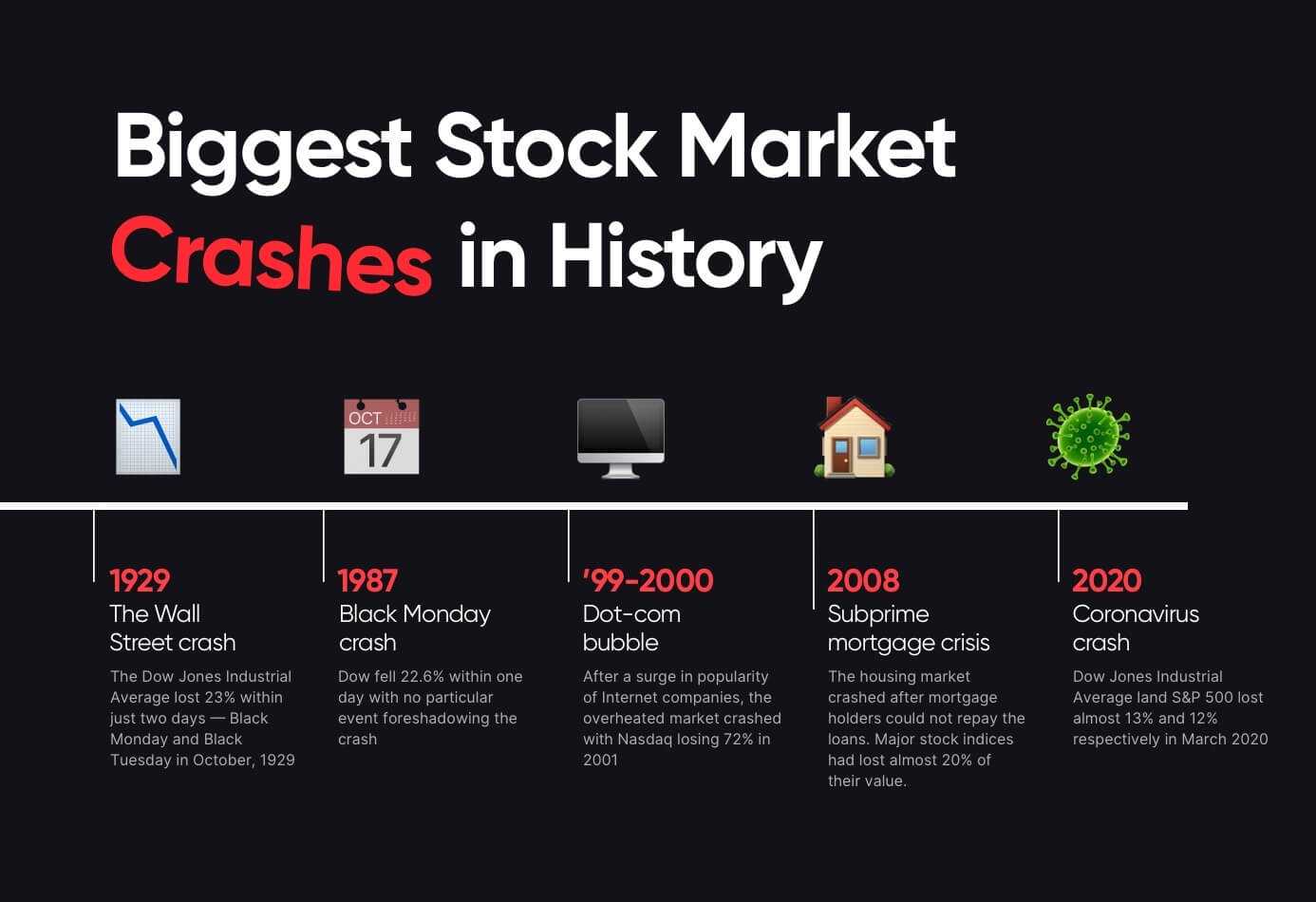Market crashes are a trader’s worst nightmare, since they can cause an over 10% drop in major stock market indices within a day or two. Stock market crashes are unpredictable and bring devastating losses to those affected. Traders and shareholders begin panic-selling in an attempt to cut their losses, which quickly escalates and might lead to more long-term and lasting effects. Today, let’s have a look at the biggest stock market crashes in history.
The Great Crash of 1929 (The Wall Street crash)
The most devastating market crash in the history of the United States started in September 1929 and was one of the reasons that led to the beginning of the Great Depression. The crash was preceded by a speculative boom in the mid-1920s, during which millions of Americans actively invested in stocks.
The “Roaring Twenties” had rural Americans move to large cities in large numbers, expecting a more prosperous life. The stock market was believed to continue growing forever, and it seemed an attractive possibility to get rich: the Dow Jones Industrial Average grew from 63 points to 381 points between 1921 and 1929. A rapidly growing demand for stocks inflated their prices, which attracted even more investors who hoped for large returns. At the same time, many individual investors were using high leverage — only paying a small percentage of the stock value, borrowing the rest of the funds from banks. Consumers were building up large debts because of easy credit and the market was extremely shaky, rapidly reacting to any doubt in its future gains. Finally, more seasoned investors realized the market was overheated and started getting out.
The Dow’s descent began in September and continued through October, resulting in a 12.82% loss on Black Monday of October 28. The following day, on Black Tuesday, the panic selling only intensified with investors trying to find buyers at any possible price (and they couldn’t). The decline continued and the index lost another 11.73% within the day, wiping out thousands of investors and resulting in billions of dollars lost.
The Wall Street crash had a huge impact on the U.S. economy and its effect went beyond the country, hitting European countries particularly hard. As a consequence, in 1934 a new regulatory body was formed in the U.S. — the Securities and Exchange commission (SEC), which developed rules and regulations designed to prevent the possibility of it ever happening again.
Black Monday crash of 1987
October 19, 1987 marks the day the Dow Jones Industrial Average had its highest one-day drop by percentage in history. It fell 22.6% within one day, even though there was no particular event that caused this crash. Potential reasons for why the market fell so quickly are considered to be computerized trading, illiquidity, market overvaluation and trading psychology.
The crisis did not just affect the United States: in fact, it spread all over the world with the stock exchange of Hong Kong losing 45,8%, Australian — 41.8%, the UK stock exchange losing 26.4% and Canadian — 22.5%.
Despite the large losses, the market recovered rather quickly, since the issue was mainly consumer confidence and computerized trading. In November 1987 the Dow already started recovering and regained all its losses by 1989.

The Dot-Com bubble of 1995-2001
Another one of the biggest stock market crashes is the Dot-Com crash in 2001. The economic bubble of dot-com companies existed between 1995 and 2001 and formed as a result of the surge in shares of Internet companies (mostly American).
At the end of the 20th century, many new Internet companies opened and old companies were trying to keep pace and move their business into the online space, too. Many optimistic investors were eager to purchase shares of online companies, overlooking any traditional fundamentals like the P/E ratio. The shares of companies offering their services through the Internet skyrocketed, and such high prices were widely justified by economists who claimed that a period of “new economy” had started. Within the 5 years between 1995 and 2000, the Nasdaq stock market index grew 400%.
In reality, the new business models turned out to be mostly ineffective and caused many online shopping companies to close during the crash. Investors were pouring their funds into unprofitable companies, which, as they hoped, would become millionaires in the future. Though eventually it was true for a few of them, like Amazon, most companies spent their funds lavishly and did not manage to grow their businesses. By October 2002, Nasdaq had decreased by 72% from its high in 2001 and it did not reach it again for more than a decade.
Subprime mortgage crisis of 2007-2010
The real estate crisis happened after lenders started giving out mortgages with high interest rates to homebuyers with low credit scores, lowering the overall standards for credit loans. This availability of mortgages appealed to those who previously were ineligible for a loan, and to investors, who bought up mortgage-backed securities and made other investments based on these so-called “subprime” loans.
The crisis unfolded when the borrowers, burdened by loans and debt, could not repay their mortgages, dragging real estate prices down. The investments made based on the opportunities afforded by the surging economy heavily indebted their owners. Financial organizations that invested in real estate assets, failed. The stock market declined and by September of 2008, the major stock indices had lost almost 20% of their value.
The housing bubble is explained in the 2015 movie “The Big Short”, which is one of the movies any trader might want to watch.
Covid-19 crash of 2020
By the beginning of 2020, the pandemic had spread in China and then moved to Europe, causing practically the whole world to enter a long period of lockdown. People were encouraged to avoid public places, restaurants, museums and theaters were closed, international travel was restricted in most countries — all preconditions for an economic decline. Struggling businesses had to lay off workers and some, especially those in the travel and hospitality industry, closed forever. The stock market reacted accordingly, with Dow Jones Industrial Average and S&P 500 losing almost 13% and 12% respectively in March 2020.
A recovery followed the decline as many businesses found a way to switch to remote work and adapted their services to the new reality. E-commerce and online technology stocks surged, as the demand for them rapidly increased. Still, the consequences of the pandemic are yet to manifest themselves in full, as many countries are still figuring the new reality out.


